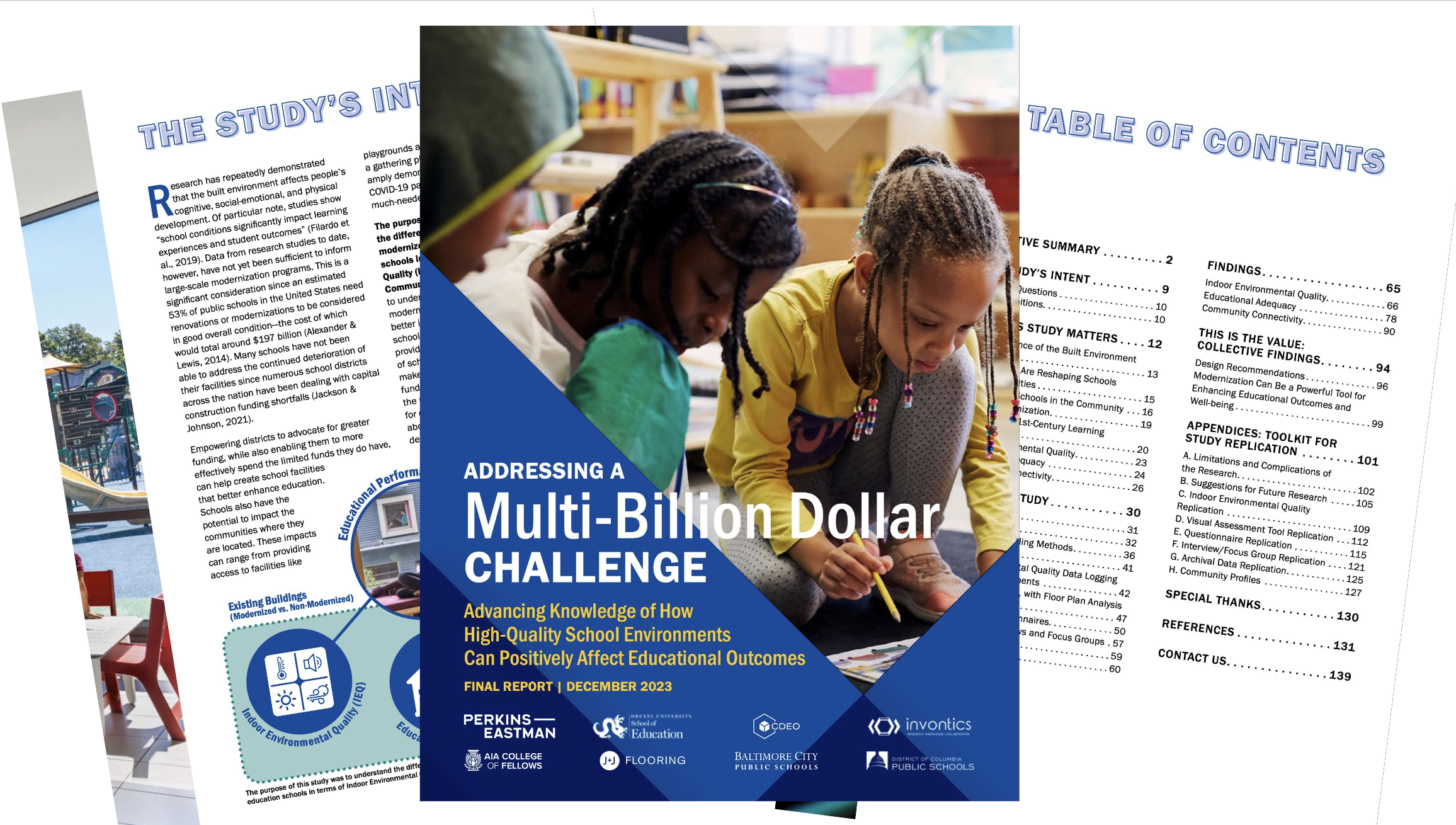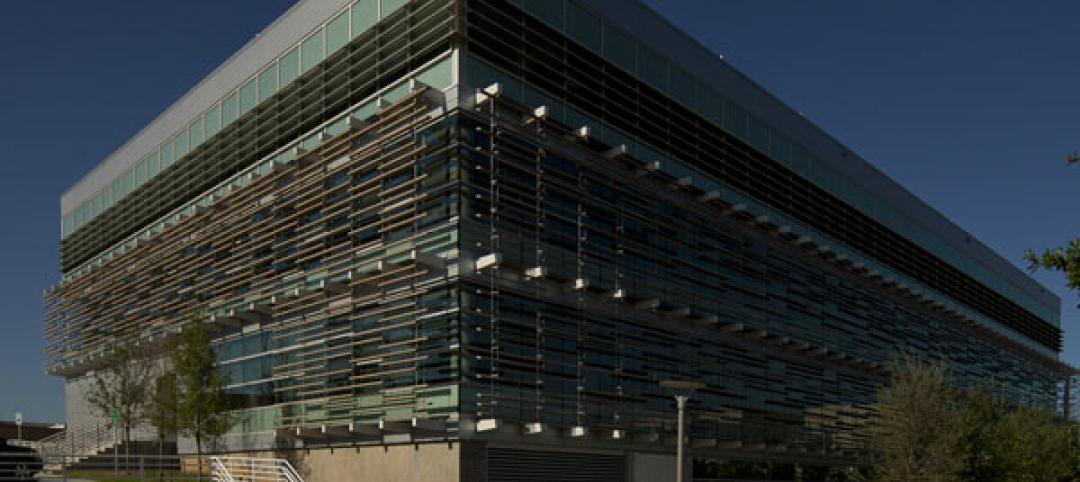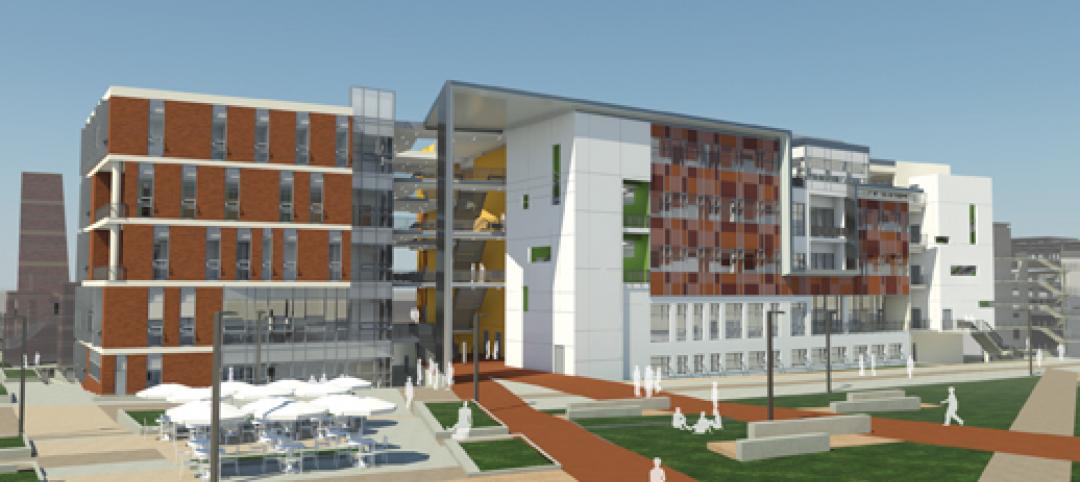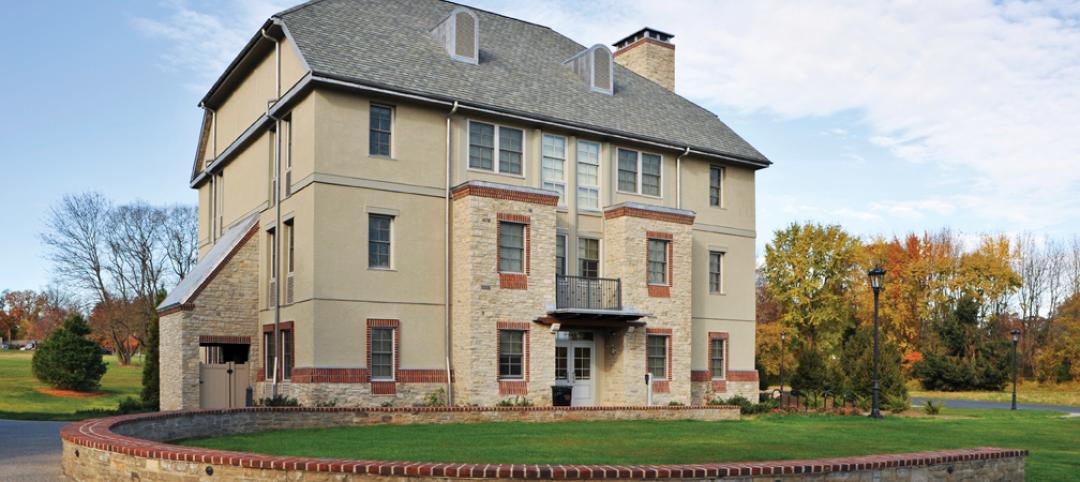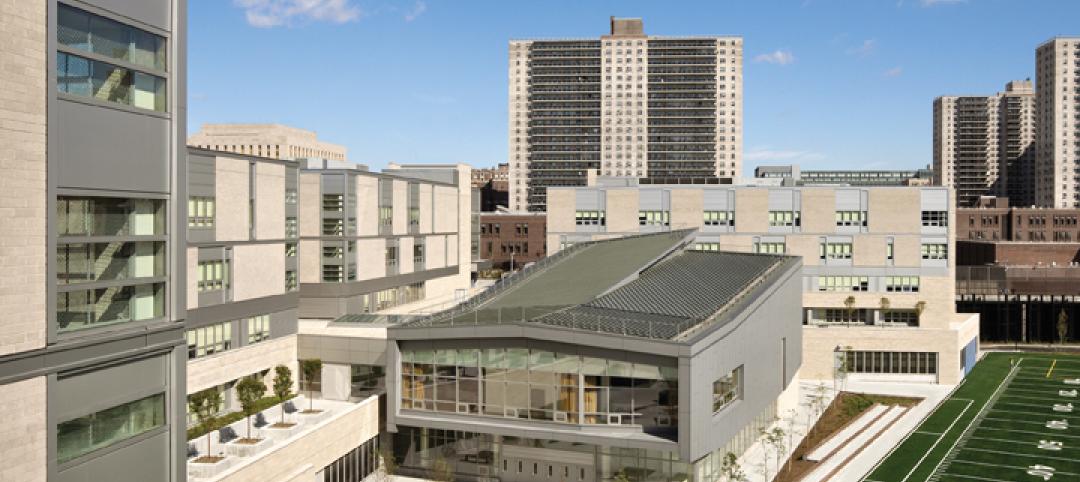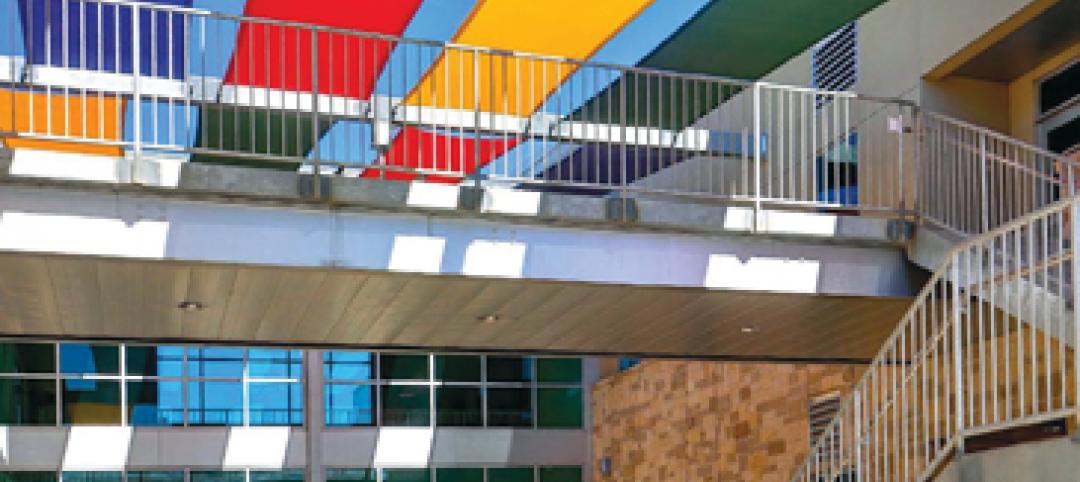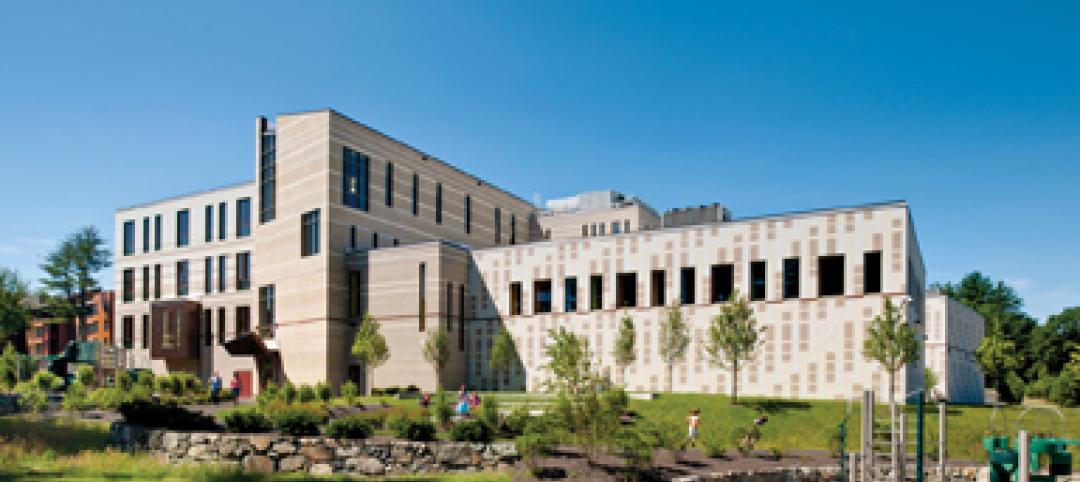The built environment matters. School districts that spend tax dollars to improve their schools can get much more than a new or renovated building. A new study suggests statistically significant connections between school modernization and occupants’ well-being and satisfaction; and that the modernization process enhances community engagement and connectivity. Evidence also indicates that school modernization has a significant positive impact on key educational indicators, including test scores, graduation rates, and enrollment over time.
Conducted by the Drexel University School of Education in conjunction with global design firm Perkins Eastman, the 140-page “Addressing a Multi-Billion Dollar Challenge” study (free download) evaluated more than two dozen schools—both modernized and non-modernized—across the District of Columbia and Baltimore City school districts. With tools to measure indoor environmental quality, assessments of design, layout, and ambiance of each building’s interior and exterior, surveys for the people who use the schools, and interviews with community members, the research team concluded that modernized schools outperformed non-modernized schools to the significant benefit of students, teachers, and staff in almost every category. (Download the free PDF report.)
This study was performed against a backdrop of alarming disinvestment in the US public schools that educate more than 49.4 million children across the country, and the average age of a public school in the US is 49 years, according to the National Center for Education Statistics. Furthermore, the annual shortfall in maintenance and improvements for those buildings is $85 billion, according to a 2021 report titled The State of Our Schools.
“Tackling the nation’s inadequate school facilities is a critical step toward supporting equitable education and community resilience,” says Sean O’Donnell, FAIA, LEED AP, principal of Perkins Eastman and co-principal investigator of the study. “Our research [suggests] that modernized schools can make a marked difference in terms of educating our children, enhancing the lives of teachers and administrators, and better engaging with the surrounding communities.” The assessed condition of a school building using these measures, O’Donnell says, “sends a message to everyone about how we value students, families, and our communities, and what our collective hopes for the future are. Modernized schools look toward a better future for all.”
Making the case for K-12 school modernization funding
Identifying the potential benefits of school modernization that will help jurisdictions build a stronger case for the importance and funding of school modernization was the goal of this study. The study’s report also provides design guidelines for how best to spend modernization dollars, as well as tools and guidance for designers and school districts who might benefit by replicating the study’s methods. The researchers found the greatest opportunities for improvement as schools plan for upgrades should focus on instructional space ambiance, exterior presence, safety and security, community assembly space, and main office location. Data revealed that school modernization made a significant impact across multiple indoor environmental quality factors—such as air quality, lighting, acoustics, and thermal comfort—which can all impact students’ ability to focus and learn.
The multi-disciplinary research team for this study investigated the differences between 28 modernized and non-modernized elementary, middle, and high schools. Students showed enhanced academic performance in the updated schools. Modernized schools also hold the potential to enhance community health and wellness while helping to anchor their communities through, among other things, providing health clinics, food distribution, and publicly accessible recreational facilities.
In 2019, the American Institute of Architects College of Fellows awarded Perkins Eastman and the Drexel University School of Education the 10th biannual Latrobe Prize, a $100,000 grant to pursue projects that can demonstrate “direct and practical impact” on people and the architecture industry. J+J Flooring provided an additional grant of $30,000. The team researched Indoor Environmental Quality (IEQ), including thermal comfort, air quality, acoustics, and lighting. Additionally, they studied Educational Adequacy (EA), which considered how well a school’s spaces and design features supported learning and teaching within that environment. Additionally, Community Connectivity (CC), evaluated how a school’s spaces and design features supported stakeholders’ perceptions about, use of, and engagement with the school. The researchers determined that, in multiple categories, modernized schools offered greater IEQ and EA than non-modernized schools, while CC had mixed though favorable results.
Bruce Levine JD, clinical professor and director of the Educational Policy Program at the Drexel University School of Education and co-principal investigator of this study, says, “The future of America’s students and their families demands that we act now to improve the academic settings where we strive to educate our young people. Investing in modernizing our schools can and will make a difference not only in the experiences of students and educators but in the ripple effects for society, our economy, and national interests.”
Related Stories
| Dec 27, 2011
USGBC’s Center for Green Schools releases Best of Green Schools 2011
Recipient schools and regions from across the nation - from K-12 to higher education - were recognized for a variety of sustainable, cost-cutting measures, including energy conservation, record numbers of LEED certified buildings and collaborative platforms and policies to green U.S. school infrastructure.
| Dec 5, 2011
RJM Construction begins building Nova Classical Academy in St. Paul
As the general contractor, RJM is constructing the 94,000-sf building that will consolidate the St. Paul school’s two other locations.
| Sep 23, 2011
Under 40 Leadership Summit
Building Design+Construction’s Under 40 Leadership Summit takes place October 26-28, 2011 Hotel at the Monteleone in New Orleans. Discounted hotel rate deadline: October 2, 2011.
| Sep 12, 2011
LACCD’s $6 billion BIM connection
The Los Angeles Community College District requires every design-build team in its massive modernization program to use BIM, but what they do with their 3D data after construction is completed may be the most important change to business as usual.
| Jul 22, 2011
Five award-winning modular innovations
The Modular Building Institute's 2011 Awards of Distinction highlight fresh ideas in manufactured construction projects.
| May 18, 2011
Former Bronx railyard redeveloped as shared education campus
Four schools find strength in numbers at the new 2,310-student Mott Haven Campus in New York City. The schools—three high schools and a K-4 elementary school—coexist on the 6.5-acre South Bronx campus, which was once a railyard.
| May 18, 2011
Eco-friendly San Antonio school combines history and sustainability
The 113,000-sf Rolling Meadows Elementary School in San Antonio is the Judson Independent School District’s first sustainable facility, with green features such as vented roofs for rainwater collection and regionally sourced materials.
| May 18, 2011
New Reform Jewish Independent school opens outside Boston
The Rashi School, one of only 17 Reform Jewish independent schools in North American and Israel, opened a new $30 million facility on a 166-acre campus shared with the Hebrew SeniorLife community on the Charles River in Dedham, Mass.
| May 18, 2011
Addition provides new school for pre-K and special-needs kids outside Chicago
Perkins+Will, Chicago, designed the Early Learning Center, a $9 million, 37,000-sf addition to Barrington Middle School in Barrington, Ill., to create an easily accessible and safe learning environment for pre-kindergarten and special-needs students.


